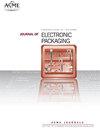Process-factor Optimization of Small-area Sintered Interconnects for Power Electronics Applications
IF 2.3
4区 工程技术
Q3 ENGINEERING, ELECTRICAL & ELECTRONIC
引用次数: 0
Abstract
Power electronics is concerned with the use of electronic devices to control and transfer electric power from one form to another. Power electronics can be found in laptop chargers, electric grids, and solar inverters. Die-attach interconnections form a critical part of power electronics devices. Silver sintering is traditionally used for die-attach interconnections because of its high melting point and ability to form very thin thicknesses. However, the processing time compared with soldering is very long. Sintered layers might contain large voids that affect the mechanical stability of the structure. Stresses caused by mechanical and environmental conditions might cause degradation and possibly early failures. This work focuses on studying the combined effect of process factors on the shear strength of small-area die-attach interconnections in silver sintering. Design of Experiments (DoE) tools were used to build an experimental matrix with a 95% confidence level. The results have shown that holding time has a considerable effect on the mechanical stability of the die-attach interconnections. Intermetallic compounds formed in the sintered joints at higher holding times resulted in lesser voids. Furthermore, the treatment level of the holding time highly affects the shear strength under the other factors of temperature and pressure.电力电子应用中小面积烧结互连的工艺因素优化
电力电子学涉及使用电子设备来控制电力并将其从一种形式传输到另一种形式。电力电子产品可以在笔记本电脑充电器、电网和太阳能逆变器中找到。芯片连接互连是电力电子设备的关键部分。银烧结传统上用于管芯连接互连,因为它的熔点高并且能够形成非常薄的厚度。然而,与焊接相比,处理时间非常长。烧结层可能包含影响结构的机械稳定性的大空隙。机械和环境条件引起的应力可能导致退化,并可能导致早期故障。本工作重点研究了银烧结中工艺因素对小面积芯片连接互连抗剪强度的综合影响。实验设计(DoE)工具用于构建具有95%置信水平的实验矩阵。结果表明,保持时间对管芯连接互连的机械稳定性有相当大的影响。在较高的保持时间下在烧结接头中形成的金属间化合物导致较小的空隙。此外,在温度和压力等其他因素的作用下,保温时间的处理水平对剪切强度有很大影响。
本文章由计算机程序翻译,如有差异,请以英文原文为准。
求助全文
约1分钟内获得全文
求助全文
来源期刊

Journal of Electronic Packaging
工程技术-工程:电子与电气
CiteScore
4.90
自引率
6.20%
发文量
44
审稿时长
3 months
期刊介绍:
The Journal of Electronic Packaging publishes papers that use experimental and theoretical (analytical and computer-aided) methods, approaches, and techniques to address and solve various mechanical, materials, and reliability problems encountered in the analysis, design, manufacturing, testing, and operation of electronic and photonics components, devices, and systems.
Scope: Microsystems packaging; Systems integration; Flexible electronics; Materials with nano structures and in general small scale systems.
 求助内容:
求助内容: 应助结果提醒方式:
应助结果提醒方式:


